
نموذج رسالة واتساب: دليل إرشادي مع 13 مثالاً
لا يمكن للشركات إرسال رسائل WhatsApp بعد 24 ساعة إلا إذا استخدمت قالب رسالة WhatsApp. تعرف على كيفية تنسيق الرسائل النموذجية وإرسالها بالإضافة إلى الأمثلة.
![محادثة AI: دليل للمحادثات التجارية الذكية [Jan 2024]](https://assets2-proxy.respond.io/ph8r57dk1q9w/1y20nO2Zg7bgPRtUom3mZH/61824a8eb13a9ca1aa3f48cde7db4f52/how-to-live-chat-greeting-cover-image_8761e6b8266ca622535be4a35648d313.png?q=70&fm=avif)
دخل الذكاء الاصطناعي المحادثات وهو هنا لإعادة تعريف تواصل العملاء. وبفضل قدراتها المتقدمة، أصبحت المحادثات الآلية التي كانت تستند إلى القواعد والمخطوطات ديناميكية وبديهية. ولكن ماذا يعني ذلك بالنسبة للأعمال التجارية؟
سيرشدك هذا الدليل في كل ما تحتاج إلى معرفته حول الذكاء الاصطناعي للمحادثات لتواصل مع العملاء. ستتعلم ما هو، كيف يعمل، وما هي الاختلافات بينه وبين برامج الدردشة التقليدية. بعد ذلك، سوف نستكشف كيف أنه's يعيد تعريف محادثات العملاء، طرق تنفيذه وأفضل الممارسات لاستخدامه بفعالية.
تشير الذكاء الاصطناعي للمحادثة إلى استخدام تكنولوجيات الذكاء الاصطناعي لمحاكاة المحادثات الشبيهة بالإنسان. وهي تستخدم كميات كبيرة من البيانات و مزيج من التكنولوجيات لفهم اللغة البشرية والاستجابة لها بذكاء.
وأفضل جزء هو أن الذكاء الاصطناعي يتعلم ويحسن ردوده من كل تفاعل، كما يفعل الإنسان. بعض الأمثلة على الذكاء الاصطناعي المحادثاتي البدائي التي قد تكون مألوفة لديك هي الروبوتات والوكلاء الافتراضيون.
قبل استكشاف كيفية تطور هذه التكنولوجيا، دعونا ننظر إلى مدى عمل المحادثة المتقدمة في الذكاء الاصطناعي.
وتجمع المحادثة بين تكنولوجيات مثل معالجة اللغات الطبيعية وتعلم الآلات لمساعدة نظم البرمجيات على محاكاة التفاعلات البشرية.
وتزود المنظمة هذه النظم بالقدرة على فهم اللغة البشرية وتفسيرها وتوليدها. إنه يترجم الفوارق الدقيقة في المحادثات البشرية إلى لغة يمكن للبرمجيات فهمها، مما يمكنها من التفاعل مع البشر بشكل طبيعي.
وفي هذه الأثناء، يمكّن التعلم الآلي هذه النظم من التعلم والتحسين من البيانات والخبرات. وهو يحلل أنماط المحادثة ويستخدم هذه الرؤى لوضع تنبؤات وقرارات مستنيرة. وبينما تقوم هذه النظم بتجهيز وتحليل المزيد من البيانات، فإن قدرتها على تقديم تنبؤات دقيقة تتعزز بمرور الوقت.
وتغذي هاتان التكنولوجيتان بعضهما البعض في دورة مستمرة، مما يعزز باستمرار خوارزميات الذكاء الاصطناعي. إليك مثال على كيفية عمل المحادثة مع العملاء.
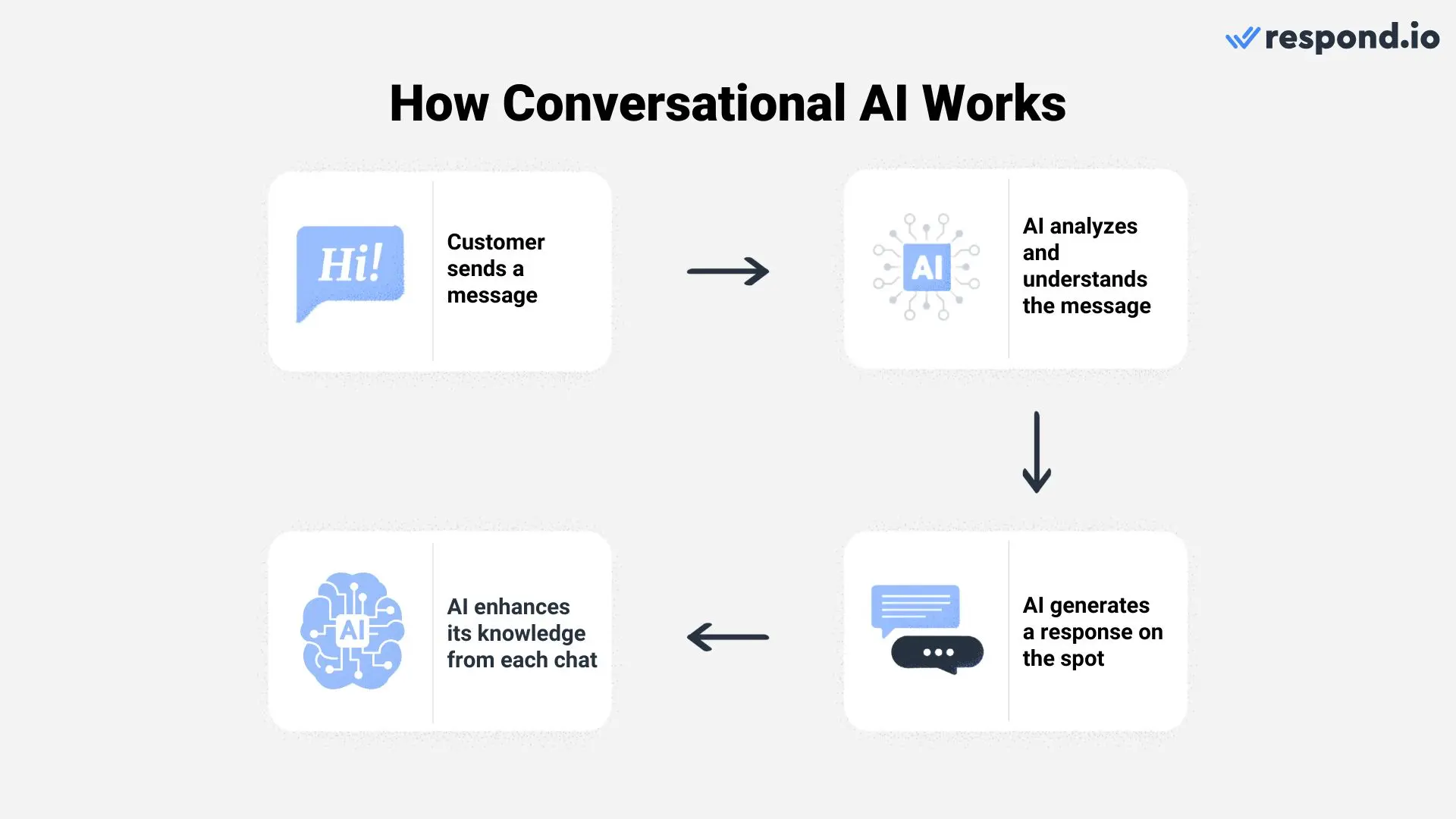
دعنا نقول إن عميلًا يستفسر عن منتجك على WhatsApp. أولا، تقوم الذكاء الاصطناعي بقراءة الرسالة، وتحللها وتفهم ما يبحث عنه العميل حقا.
ثم يأتي برد على أساس فهمه. إنها ليست مجرد إخراج للإجابات المكتوبة مسبقًا؛ بل تقوم بصياغة الردود بشكل مباشر. وفي حين أنها تتفاعل مع العملاء، فإنها تتعلم من ردودها لتعزيز دقتها بمرور الوقت.
الآن بعد أن تعلمون كيف يعمل، سنجيب على سؤال شعبي: ما الذي يجعل الذكاء الاصطناعي الحديث مختلفا عن الروبوتات التقليدية؟
وببساطة، فإن تكنولوجيات الذكاء الاصطناعي الحديث اليوم تشكل تطوراً كبيراً من روبوتات الدردشة التقليدية.
تعمل روبوتات الدردشة التقليدية استناداً إلى قواعد ونصوص محددة مسبقاً، لذا فإن ردودها تقتصر على مجموعة ضيقة من المدخلات. ويمكنها أن تعالج بسهولة مسائل مباشرة ويمكن التنبؤ بها ولكنها تواجه طلبات معقدة أو غير متوقعة.
المحادثة الاصطناعية، التي تستخدم تكنولوجيات متقدمة مثل ML و NLP، تولد بشكل دينامي استجابات مبنية على مدخلات المستخدم بدلا من أن تكون مقصورة على نص محدد. وهو يستمد إجابات من AI'قاعدة معارف واسعة لمعالجة طائفة أوسع من المواضيع والتكيف مع الأسئلة الغامضة أو المثقلة بالسياق.
الروبوت التقليدي ضد المحادثة AI
الميزة | الروبوت التقليدي | الذكاء الاصطناعي للحوار |
|---|---|---|
القدرة | قادر على معالجة الاستفسارات الأساسية | القدرة على معالجة مسائل أكثر تعقيدا |
آلية الاستجابة | فقط يستجيب للكلمات المفتاحية الدقيقة | توليد الردود استنادًا إلى إدخال المستخدم |
القابلية للتكيف | غير قادر على الابتعاد عن مسارات الدردشة المحددة مسبقاً | يتكيف مع الاستفسارات غير المتوقعة باستخدام تعلم الآلة (ML) |
قاعدة المعارف | يعتمد على قاعدة بيانات أسئلة محددة مسبقاً والإجابات | يستخدم معارف AI الواسعة |
وبالإضافة إلى ذلك، فإن نظم المعلومات والاتصال أكثر قدرة على التعرف على الفوارق الدقيقة اللغوية المختلفة والتكيف معها، مثل اللهجات الهوائية أو اللهجات الإقليمية. وهذا يعطيها القدرة على الحصول على المزيد من التفاعلات الشبيهة بالإنسان.
وباختصار، في حين أن روبوتات الدردشة التقليدية تستند إلى القواعد ومحدودة النطاق، وتوفر نظم المعلومات والاتصالات نهجاً أكثر مرونة وتكييفاً يتيح تجربة محادثة مماثلة للتفاعل البشري.
إذاً، هل تحتاج الشركات إلى محادثة الذكاء الاصطناعي لمحادثات العملاء؟ سوف نستكشف الجواب في القسم التالي.
حوّل محادثات العملاء إلى نمو الأعمال مع respond.io. ✨
قم بإدارة المكالمات والدردشات والبريد الإلكتروني في مكان واحد!
قبل استكشاف فوائد الذكاء الاصطناعي المحادثاتي، يجب أن تفهم أولاً أهميته في اتصالات العملاء. اليوم، يمكن أن تجري محادثات العملاء عبر مختلف القنوات، بما في ذلك المكالمات الهاتفية، والبريد الإلكتروني وتطبيقات الرسائل.
مع التفضيل المتزايد لتطبيقات المراسلة على رسائل البريد الإلكتروني أو المكالمات، قدمت هذه القنوات فرصًا للشركات للتواصل وإسعاد عملائها وتحويلهم. في الواقع، تكشف دراسة أن 75% من العملاء يقومون بشراء بعد الدردشة على تطبيق المراسلة، تسليط الضوء على فعاليته كأداة للتحويل.
"ولئن كانت قنوات المراسلة تتيح فرصاً عديدة، فإن الأعمال التجارية كثيراً ما تتردد في استخدامها كجزء من استراتيجيتها الخاصة بالعملاء. وذلك لأن التعامل مع الكميات الكبيرة من المحادثات يمكن أن يكون صعبا، وهم لا يريدون التضحية بجودة الخدمات.
"هذا هو المكان الذي تضيف فيه الذكاء الاصطناعي المحادثاتي قيمة من خلال توفير استجابات سريعة وعالية الجودة على نطاق أوسع بكثير بتكلفة أقل،" قال جيراردو سالاندرا، المؤسس المشارك والرئيس التنفيذي لـ respond.io ورئيس جمعية الذكاء الاصطناعي في هونغ كونغ.
بهذا الفهم، دعنا نستكشف بمزيد من التفصيل كيف يمكن للذكاء الاصطناعي المحادثاتي أن يعود بالفائدة على عملك.
Gartner يتوقع أنه بحلول عام 2026، سيتم أتمتة واحد من كل 10 تفاعلات لوكلاء خدمة العملاء، وستؤدي عمليات نشر الذكاء الاصطناعي المحادثي في مراكز الاتصال إلى تقليل تكاليف عمل الوكلاء بمقدار 80 مليار دولار.
تخيلوا فريقا من 10 وكلاء مكرسين لتقديم استجابات عالية الجودة، ولكنهم كانوا مقيدين بمناقشة حفنة من المحادثات في وقت واحد. وتنفيذ التحدث عن الذكاء الاصطناعي يغير هذا السيناريو بشكل كبير.
وخلافا للعوامل البشرية، تعمل منظمة AI المحادثة على مدار الساعة، وتقدم دعما مستمرا للعملاء على الصعيد العالمي، بغض النظر عن المناطق الزمنية. وعلاوة على ذلك، فإن قدرتها على الترجمة والاستجابة بلغات متعددة توسع نطاقها العالمي، وتفكك الحواجز اللغوية، وتوسع قاعدة العملاء.
وعلى أفضل وجه، تقوم منظمة العفو الدولية بكل هذه الأمور بينما تحافظ على استجابات عالية الجودة على نطاق أوسع بكثير. ويمكنها أن تتعامل مع المئات من المحادثات في آن واحد وبكفاءة أكبر وبتكلفة مخفضة.
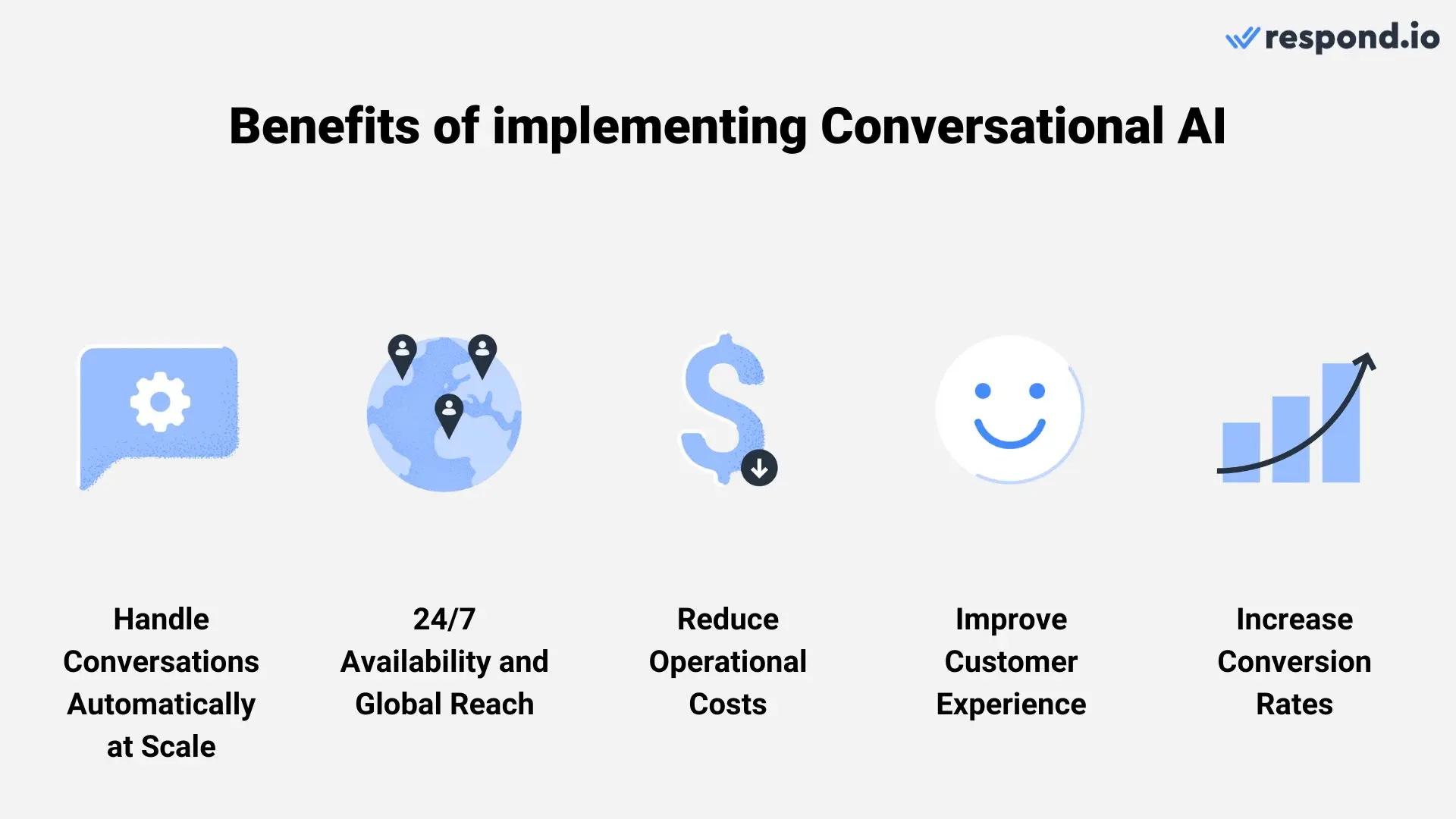
لدعم هذا السرد، تظهر دراسة أن نصف 300 من قادة مراكز الاتصال وتكنولوجيا المعلومات الذين تم استطلاع آرائهم أبلغوا أن الذكاء الاصطناعي المحادثي ساعد في خفض التكاليف التشغيلية.
حيث تدير الذكاء الاصطناعي ما يصل إلى 87٪ من تفاعلات العملاء الروتينية تلقائياً، فهو يقلل إلى حد كبير من الحاجة إلى التدخل البشري بينما يحافظ على الجودة على قدم المساواة مع التفاعلات البشرية. وقد أدت هذه الكفاءة إلى زيادة في إنتاجية العوامل وتسارع في حل المسائل المتعلقة بالعملاء.
ومن الواضح أن هذا الاتجاه يتجاوز خفض التكاليف. وهو يعزز إلى حد كبير الكفاءة في إدارة الكميات الكبيرة من المحادثات، ويساعد الوكلاء على إدارة المحادثات ذات القيمة العالية على نحو فعال.
بالإضافة إلى ذلك، فإن دمج الذكاء الاصطناعي مع الوكلاء البشريين يضمن أن تكون تفاعلات العملاء متعاطفة وشخصية. ومع تلقي العملاء استجابات سريعة ودقيقة تلبي احتياجاتهم، يمكن للأعمال التجارية أن تحسن رضا العملاء وتعزز معدلات التحويل.
وهذا بدوره يمنح الأعمال التجارية ميزة تنافسية، ويعزز النمو ويتفوق على منافسيها. بعد مناقشة الفوائد، دعنا نستكشف التحديات والقيود.
ويطرح إدراج محادثة الذكاء الاصطناعي في تفاعلات العملاء عدة تحديات على الرغم من إمكانية تبسيط الاتصالات.
تتمثل إحدى القيود المهمة في صعوبة الذكاء الاصطناعي في فهم الفوارق الدقيقة في التواصل البشري مثل السخرية والسياق الثقافي والنغمة العاطفية. ويتضح ذلك بشكل خاص في الحالات التي تتطلب ذكاء عاطفي عالٍ، حيث لا غنى عن الرقابة البشرية.
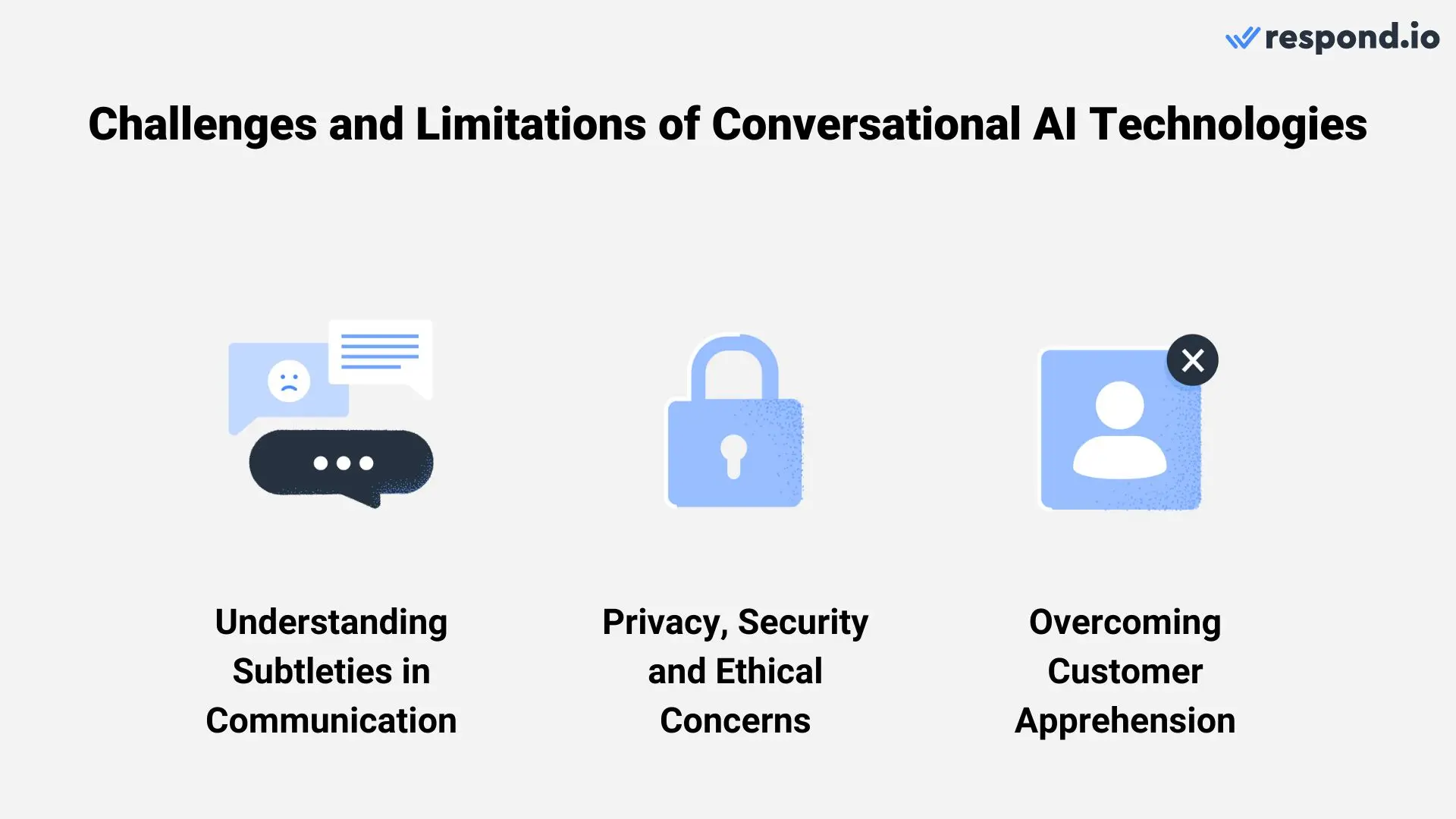
وإلى جانب ذلك، فإن الاعتماد على مجموعات واسعة من البيانات يثير شواغل تتعلق بخصوصية العملاء وأمنهم. والتقيد بالأنظمة مثل GDPR و CCPA أمر أساسي، ولكن كذلك تلبية توقعات العملاء' بشأن استخدام البيانات الأخلاقية. ويجب على الأعمال التجارية أن تكفل امتثال تكنولوجيات المعلومات والاتصالات قانونياً وشفافيتها وغير متحيزة للحفاظ على الثقة.
كما يشكل تخوف العملاء تحدياً، غالباً بسبب المخاوف المتعلقة بخصوصية البيانات وقدرة AI على معالجة الاستفسارات المعقدة. ويتطلب التخفيف من هذا الأمر اتصالات شفافة بشأن قدرات الذكاء الاصطناعي وتدابير قوية لخصوصية البيانات من أجل طمأنة العملاء.
الآن بعد أن أصبح لديك جميع المعلومات الأساسية عن المحادثة AI، لقد حان الوقت للنظر في كيفية تنفيذه في محادثات العملاء وأفضل الممارسات لاستخدامه بفعالية.
حوّل محادثات العملاء إلى نمو الأعمال باستخدام respond.io. ✨
إدارة المكالمات والدردشات والبريد الإلكتروني في مكان واحد!
ويتجاوز إدماج المحادثة في تفاعلات العملاء مجرد اختيار منصة مناسبة - وهو ينطوي أيضا على طائفة من الخطوات الأساسية الأخرى.
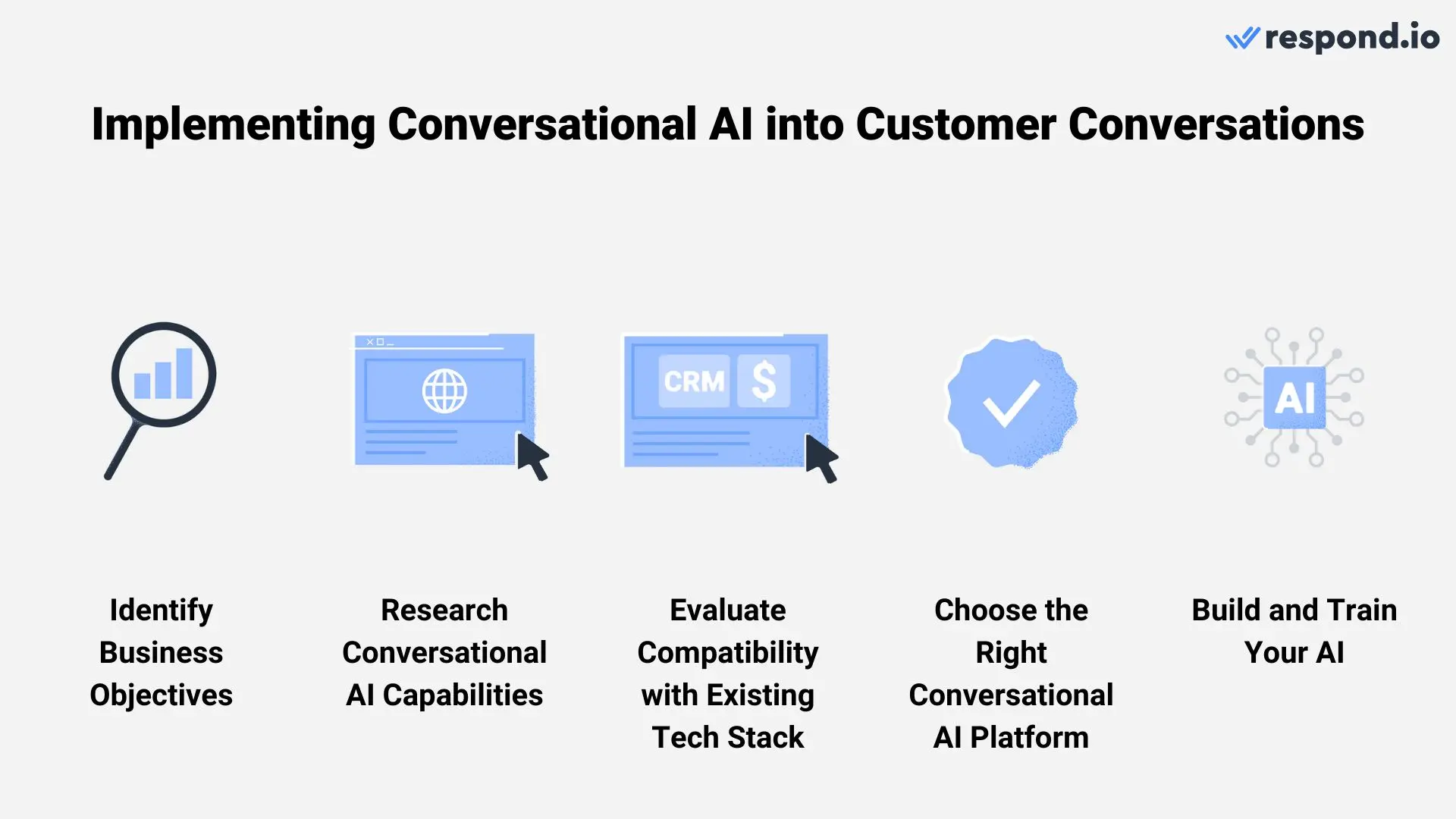
وتشمل الرحلة خمس مراحل رئيسية:
تحديد أهداف الأعمال التجارية
بحث القدرات التي تحتاجها
تأكد من التوافق مع تكدس التكنولوجيا الموجود لديك
اختر المنصة الصحيحة للذكاء الاصطناعي.
درب الذكاء الاصطناعي لمواءمة أهدافك
دعونا نستكشف كيفية التنقل في هذه المراحل من أجل نجاح تنفيذ الذكاء الاصطناعي.
ابدأ من خلال التحديد الواضح لأهداف الأعمال التجارية المحددة التي تهدف إلى تحقيقها باستخدام الذكاء الاصطناعي. تحديد المناطق التي يمكن فيها إضافة القيمة الأكبر، سواء في التسويق، المبيعات أو دعم العملاء.
على سبيل المثال، يمكن أن تشمل أهدافك إدارة كميات كبيرة من المحادثات تلقائياً، وتعزيز تفاعل العملاء، وحل القضايا بكفاءة، وتخصيص رحلات الشراء، وتقديم معلومات دقيقة، والمزيد.
وستكون أهدافكم بمثابة خريطة طريق لاختيار الأدوات المناسبة في مجال الذاكرة وتكييفها وفقا لاحتياجاتك الخاصة. مع تعريف أهدافك بوضوح، الخطوة التالية هي البحث عن القدرات المحددة التي تحتاج منصة الذكاء الاصطناعي الخاصة بك إلى امتلاكها.
استناداً إلى أهدافك، فكر فيما إذا كانت الروبوتات التقليدية كافية أو إذا كان عملك يتطلب قدرات متقدمة في الذكاء الاصطناعي. لاحظ أن بعض مقدمي الخدمات قد يسمون روبوتات الدردشة التقليدية بأنها "قدرة AI" رغم افتقارها إلى التكنولوجيات مثل NLP وML.
بعض القدرات التي يجلبها الذكاء الاصطناعي في المحادثات تشمل تخصيص التفاعلات باستخدام بيانات العملاء، وتحليل المشتريات السابقة لتقديم توصيات، الوصول إلى قواعد المعرفة لضمان الردود الدقيقة وأكثر من ذلك.
بمجرد فهمك الواضح للمميزات التي تحتاجها، أحد العوامل الحاسمة التي يجب النظر فيها قبل اختيار منصة الذكاء الاصطناعي للمحادثة هو توافقها مع تكدس البرمجيات الحالي.
عند النظر في منصة الذكاء الاصطناعي للمحادثة، تأكد من أنها يمكن أن تدمج بسلاسة مع البرامج الموجودة لديك، مثل CRM أو منصات التجارة الالكترونية. وهذا يكفل سلاسة سير العمل ويمنع مشاكل التكامل.
بمجرد فهمك الواضح لاحتياجاتك وكيفية توافقها مع نظامك الحالية، الخطوة التالية هي اختيار أفضل منصة لعملك.
اختيار منصة الذكاء الاصطناعي المناسبة أمر بالغ الأهمية، حيث ستعتمد عليها أعمالك بشكل كبير في إدارة محادثات العملاء. إذا كانت أعمالكم التجارية تنمو بسرعة، فابحث عن حل يمكن تطويره وتكييفه مع الاحتياجات المستقبلية والتقدم التكنولوجي.
يجب أن توفر المنصة الصحيحة جميع الميزات التي تحتاجها، وسهولة التكامل، دعم قوي لأحجام المحادثات العالية والمرونة للتطور مع عملك.
والأهم من ذلك أن المنصة يجب أن تتقيد بـ أنظمة حماية البيانات العالمية مثل GDPR و CCPA، مما يضمن سلامة خصوصية البيانات وأمنها. مع اختيار المنصة الصحيحة، الخطوة التالية هي التركيز على تدريب الذكاء الاصطناعي.
اعتماداً على المنصة المختارة، يمكنك تدريب الوكيل الذكي لعكس كفاءة أفضل الوكلاء البشريين. يمكنك دمج الذكاء الاصطناعي في سير العمل الحالي، مما يمكّنه من القيام بدور الرد الابتدائي على الاستفسارات الروتينية وتوجيه المحادثات الأكثر تعقيدًا أو حساسية إلى الوكلاء البشريين.
وبالإضافة إلى ذلك، فإن تدريب الذكاء الاصطناعي على تقديم ردود دقيقة أمر بالغ الأهمية. وهذا ينطوي على تزويدها بمعلومات مستكملة، غالبا ما تكون مستمدة من موارد موجودة مثل مقالات قاعدة المعارف أو الأسئلة الشائعة. وهذا يضمن أن تظل الذكاء الاصطناعي مهمة وفعالة في معالجة استفسارات العملاء، تساعدك في نهاية المطاف على تحقيق أهداف عملك.
الآن بعد أن كنت تعرف ما تحتاجه لتنفيذ محادثة الذكاء الاصطناعي في محادثة العملاء، دعونا ننظر إلى بعض أفضل الممارسات.
إن إدراج المحادثة AI في استراتيجية خدمة العملاء الخاصة بك يمكن أن يعزز إلى حد كبير الكفاءة ورضا العملاء.
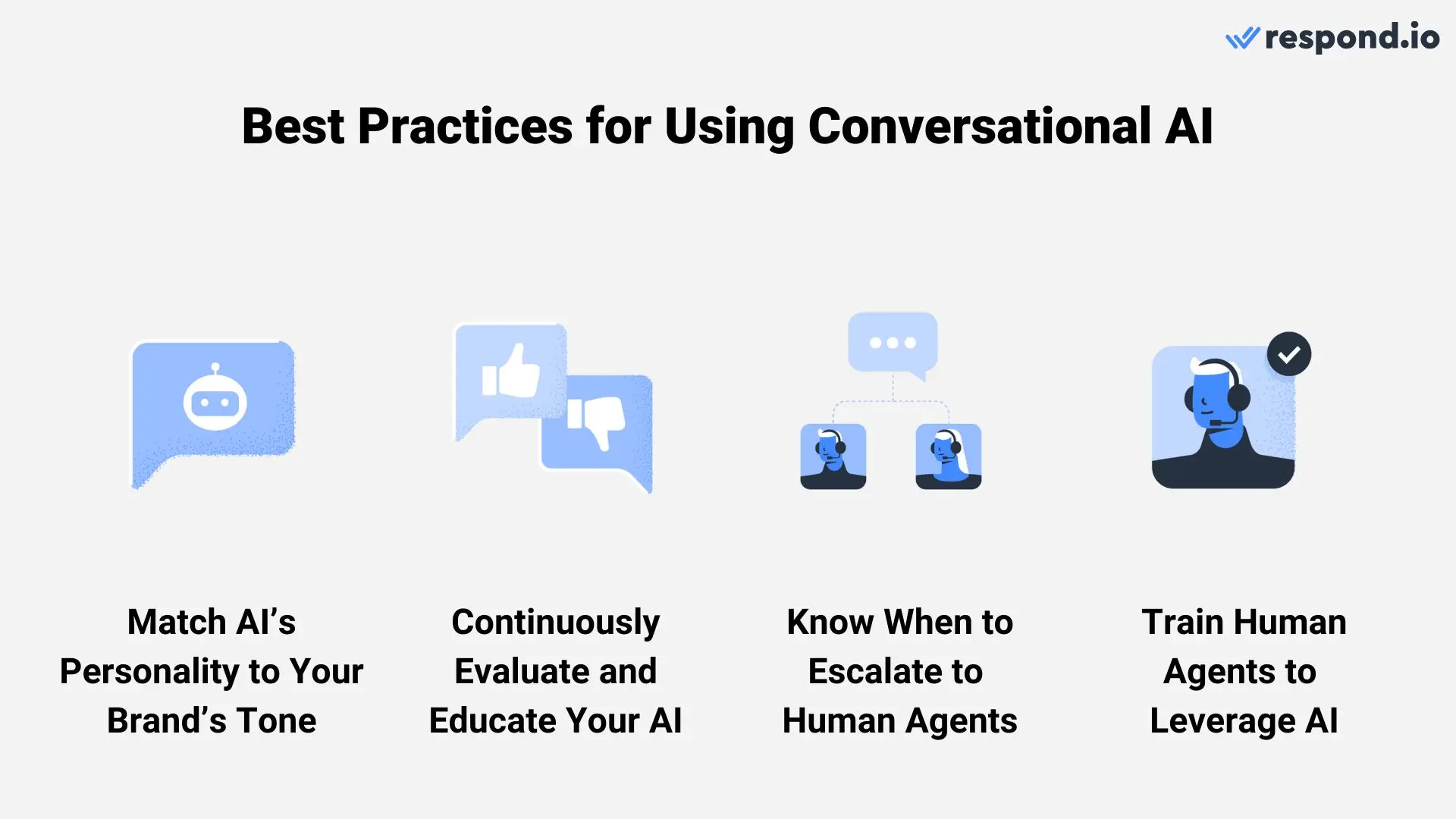
لكن، للاستفادة إلى أقصى حد من هذه التكنولوجيا، من المهم'أن تتبع بعض أفضل الممارسات.
بواسطة مواءمة شخصية الذكاء الاصطناعي مع نغمة علامتك التجارية، يمكنك تحسين تجربة العملاء، مما يجعل المحادثات تبدو أكثر شخصية وقابلية للتواصل. وهذا النهج لا يعزز هويتك التجارية فحسب بل يعزز أيضا اتصالا أقوى مع جمهورك.
وبعد أن تطابق شخصية آي آي مع لهجة العلامة التجارية الخاصة بك، دعونا نستكشف الآن أفضل ممارسة أخرى بالغة الأهمية: التقييم المستمر والتعليم.
وتتوقف فعالية المحادثة على قدرتها على التعلم والتكيف. قيم أدائه باستمرار لضمان تحقيقه لأهدافك واحتفظ به محدثًا بمعلومات جديدة.
تضمن التحديثات المنتظمة لمعلوماتها أن تبقى الذكاء الاصطناعي ملائمًا وفعالًا في التعامل مع مختلف التفاعلات مع العملاء. تُعد هذه العملية المستمرة للتقييم والتعليم أمرًا حيويًا، ولكن من المهم أيضًا التعرف على الحالات التي يكون فيها التدخل البشري أكثر ملاءمة.
وعلى الرغم من تطور منظمة العفو الدولية، فإن بعض القضايا المعقدة أو الحساسة قد تتطلب تدخلاً بشرياً. دمج مسار تصعيد سلس إلى الوكلاء البشريين في مثل هذه السيناريوهات، مع ضمان أن يكون الانتقال سلسًا وأن يكون لدى الوكلاء وصول سريع إلى سياق التفاعل.
وهذا يؤدي إلى أفضل الممارسات التالية ــ تدريب وكلاء بشريين على استخدام أدوات الذات.
استنادًا إلى ميزات منصتك المحددة، يمكنك تزويد الوكلاء بأدوات الذكاء الاصطناعي المتطورة لتعزيز تفاعلهم مع العملاء. دعونا نأخذ الرد على ذلك كمثال.
طلبات Respond AI يمكن أن تساعد الوكلاء في صقل رسائلهم، مما يضمن وضوحًا ودقة في التواصل. يمكنهم أيضًا ترجمة الرسائل إلى لغات مختلفة، مما يقلل من الحواجز اللغوية المحتملة.
يمكن أن يكون أدوات الذكاء الاصطناعي مثل مساعد الذكاء الاصطناعي محورية في توفير وصول سريع للوكلاء إلى المعلومات ذات الصلة. يسمح هذا الوصول السريع إلى المعلومات للوكلاء بالاستجابة بسرعة وبدقة لاستفسارات العملاء، مما يعزز أوقات الاستجابة ويساهم في تجربة عملاء أكثر إرضاءً.
وتحتل منظمة العفو الدولية مكان الصدارة في عصر جديد في إشراك العملاء، مما يوفر تحولاً ثورياً عن أساليب الاتصال التقليدية.
كما أننا'وفى استكشافنا في هذا الدليل، فإن دمج تكنولوجيات الذكاء الاصطناعي المتقدمة يمكّن الشركات من إجراء تفاعلات أكثر ديناميكية وبديهية وشخصية مع العملاء. وخلافاً لروبوتات الدردشة التقليدية، فهي توفر عمقاً من الفهم والقدرة على التكيف، مما يسمح بإجراء محادثات تردد صداها حقاً مع العملاء.
وفي حين أن هذه التكنولوجيا التحويلية ليست خالية من التحديات، فإن مسار الذكاء الاصطناعي المحادثاتي هو في تزايد مستمر، ويتطور باستمرار للتغلب على هذه القيود.
"وصل الذكاء الاصطناعي أخيرًا إلى مرحلة يمكن فيها للشركات الحفاظ على جودة الخدمة على نطاق أوسع وبكلفة أقل. "وعلى ذلك، قال جيراردو سالاندرا، إن الشركات التي تتبنى هذا أولاً ستتمتع بميزة كبيرة على منافسيها.
وفي عالم تتزايد فيه توقعات العملاء باستمرار، فإن التمسك بالأساليب التقليدية قد يجعل العمل التجاري يتأخر. يعتبر الذكاء الاصطناعي المحادثاتي ليس مجرد أداة للحاضر، بل استثمارًا لمستقبل حيث تكون التفاعلات الذكية والمتعاطفة مع العملاء هي القاعدة.
حوّل المحادثات مع العملاء إلى نمو للأعمال باستخدام respond.io. ✨
إدارة المكالمات والدردشة والبريد الإلكتروني في مكان واحد!
محادثة الذكاء الاصطناعي هي نوع من الذكاء الاصطناعي يمكنه محاكاة المحادثة البشرية. يمكن تحقيق ذلك من خلال معالجة اللغات الطبيعية (NLP)، وهو مجال من مجالات الذكاء الاصطناعي الذي يسمح للحواسيب بفهم ومعالجة اللغة البشرية، بالإضافة إلى نماذج جوجل الأساسية التي تدعم قدرات الذكاء الاصطناعي الجيل الجديد.
ابدأ بتحديد أهداف واضحة والجمهور المستهدف، ثم اختر التكنولوجيا المناسبة والمنصات المتوائمة مع أهدافك. وبعد ذلك، استخدم تدفقات الحوار الجذابة والواعية بالسياق، وكن مستمراً في الاختبار والتنقيح بناءً على ردود فعل المستخدمين وبيانات التفاعل.
ابحث عن القدرة على الاندماج مع الأنظمة الموجودة لديك. من الضروري أيضًا أن تأخذ في الاعتبار تجربة المستخدم، خيارات التخصيص وقابلية توسيع البرنامج لتكييفه مع احتياجات الأعمال المتنامية.
هل تحتاج إلى توجيه بشأن اختيار أفضل منصة محادثة AI لعملك؟ ستوفر لك مقالتنا التفصيلية المعلومات التي تحتاجها. وإذا كنت مستعداً للشروع في تعزيز محادثات العملاء باستخدام الذكاء الاصطناعي، ابدأ رحلتك مع respond.io، وهو برنامج إدارة محادثات العملاء المدعوم بالذكاء الاصطناعي – جربه مجاناً اليوم!
إذا كنت ترغب في معرفة المزيد عن الذكاء الاصطناعي للمحادثات مع العملاء، إليك بعض المقالات التي قد تهمك.
غابرييلا كاتبة محتوى في respond.io، متخصصة كسلطة الفريق في WhatsApp منذ عام 2022. بكالوريوس في الاتصالات ساعد غابرييلا على تحسين مهاراتها كأخصائية تسويق في شركة استضافة مواقع. معرفتها العميقة بتطبيقات المراسلة، وصناعة SaaS، وسلوك العملاء تجعل مقالاتها مرجعية أساسية للأعمال التقنية.

لا يمكن للشركات إرسال رسائل WhatsApp بعد 24 ساعة إلا إذا استخدمت قالب رسالة WhatsApp. تعرف على كيفية تنسيق الرسائل النموذجية وإرسالها بالإضافة إلى الأمثلة.